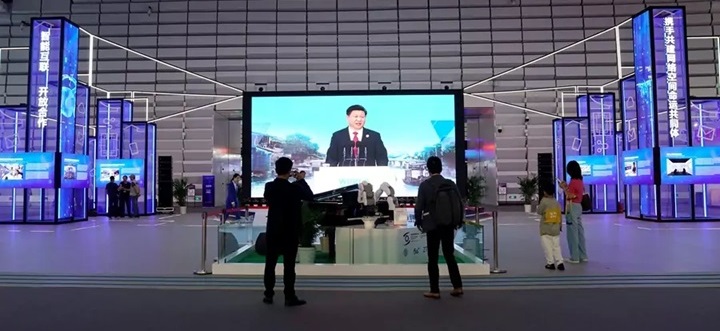
China’s domestic imbalances and overcapacity, due to state subsidies, have for the first time taken center stage in trade talks with the USA, further complicating the already complex bilateral ties. In Beijing last week, American Secretary of Commerce Janet Yellen argued that Chinese internal overcapacity in crucial sectors such as electric cars, solar panels, and telecommunications—bred through calculated national policies of targeted support—is key to bilateral trade imbalances.
This means that the decades-old, thorny issue of US-China trade imbalances has moved beyond the simple metrics of mere quantity—so many hundreds of billions a year to be settled somehow—and has touched on the core of China’s strategic plan: Beijing’s ambition to equal or surpass the technological production of the U.S.
For Beijing, technological innovation in new productive forces is necessary as the U.S. de-risking policy aims to cut China out of its technology transfer. The U.S. accuses China of serious IPR violations and of using dual-use technology for military purposes. According to a Xinhua report on the April 2 phone call between President Xi Jinping and Joseph Biden, China argued: “The U.S. side has adopted a string of measures to suppress China’s trade and technology development, and is adding more and more Chinese entities to its sanctions lists. This is not “de-risking,” but creating risks. If the U.S. side is willing to seek mutually beneficial cooperation and share in China’s development dividends, it will always find China’s door open. Still, if it is adamant on containing China’s hi-tech development and depriving China of its legitimate right to development, China is not going to sit back and watch.”[1]
A few days later, Yellen replied that trade and technology are intertwined; China’s overcapacity is at the heart of global trade imbalances. The atmosphere of her meetings in Beijing was apparently warm and cordial, yet her message was ice-cold. While it might not be openly political but technological, the race is ongoing.
China has invested in new productive forces, and the USA is undergoing its own A.I. revolution. China and the West are diverging in their paths to developing new technology. In the short term, we could see Chinese dominance due to its overcapacity. Nevertheless, the West promises to develop a new generation of technology that will outclass the Chinese and gradually render it obsolete.
In a broader scope, this situation could echo the dynamic between Japanese and U.S. technology in the 1980s. The Japanese seemed to lead the race, but then the USA introduced a new generation of computers and the internet, leaving Japanese tech behind.
Yet, will the West deliver on its promise? Or will China invent something that outsmarts Western scientists? In the past few years western tech appeared to be still ahead. The West produced effective vaccines for Covid, China did not. Despite this, China maintains that their path is the only way forward.
Markets for technology
The market for technological development is critical because it generates resources to finance research. Hence, market penetration will be a battlefield. Theoretically, the West has an advantage due to its lucrative domestic markets; by restricting or limiting sales of Chinese tech within these markets, the West could complicate China’s efforts.
However, this approach could prove costly for the West, as Chinese imports offer a distinctive price advantage.
In any case, without a political or diplomatic breakthrough, the likely scenario involves global trade becoming segmented into two categories—high-tech and low-tech goods—with some grey areas for “smuggling” but an increasing separation of the two regions. With the rise of U.S. de-risking, trade in high-tech goods with China could be limited.
History has seen similar segregations. Drugs and weapons were once freely traded but became strictly regulated over time. Similarly, labor movement between countries, once freely allowed, is now tightly controlled. This shift occurred as the world recognized the dangers of the free movement of drugs, weapons, or labor.
There’s a growing perception of the systemic dangers of free trade in technology with China, as China is viewed as a threat in the West, irrespective of the accuracy of this perception. Unless this perception changes, the trend toward division will deepen, steering global trade in a new direction from the past three decades.
The resolution won’t be easy or swift, and the eventual victor remains uncertain. With China having installed 3.38 million of the world’s 4 million 5G base stations, its market penetration could increase, challenging American technology to replace inexpensive and reliable Chinese tech in developing countries.
China’s domestic challenges
However, China does not only face challenges on the foreign front. As The Economist argued, addressing the issue of high-tech foreign penetration might not solve the inherent problem of poor domestic demand in China.
China’s response is a strategy built around what officials call “new productive forces”. This eschews the conventional path of a big consumer stimulus to reflate the economy … Instead Mr Xi wants state power to accelerate advanced manufacturing industries, which will in turn create high-productivity jobs, make China self-sufficient and secure it against American aggression. China will leapfrog steel and skyscrapers to a golden era of mass production of electric cars, batteries, biomanufacturing and the drone-based “low-altitude economy”… Mr Xi’s ultimate aim is to invert the balance of power in the global economy. Not only will China escape dependence on Western technology, but it will control much of the key intellectual property in new industries and charge rents accordingly. Multinationals will come to China to learn, not teach.
However, Mr Xi’s plan is fundamentally misguided. One flaw is that it neglects consumers. Although their spending dwarfs property and the new productive forces, it accounts for just 37% of GDP, much lower than global norms. To restore confidence amid the property slump and thereby boost consumer spending requires stimulus. To induce consumers to save less requires better social security and health care, and reforms that open up public services to all urban migrants. [2]
Consumer confidence remains low post-Covid. People are not investing or spending; they are saving. Several factors contribute to this trend.
- First, the long anti-corruption campaign has failed to yield new open and transparent business regulations that legally protect private property, an economic cornerstone. In China, asset ownership remains at the discretion of political power, which can deem assets illegitimate or illegal through secretive party procedures and confiscate them.
- Second, the extended Covid lockdowns, harsh in implementation and longer than the rest of the world’s, stripped many Chinese citizens of a sense of future security. Businesses closed, and people went months without income or salary, or without state compensation, surviving only if they had savings. The possibility of new lockdowns do not seem impossible.
- Third, the absence of a welfare state means individuals must save for education, healthcare, and retirement. There are no extensive private insurances or a state system to provide them. With tax collection at half the rate of European countries that support welfare states, China would need to increase taxes on its middle class, potentially causing discontent or demands for political representation in exchange.
- Finally, aggressive rhetoric in Chinese media about war preparation and foreign threats prompts ordinary people to save rather than spend or invest, unable to plan for a peaceful future.
These challenges will pose significant obstacles for China, necessitating increased exports to compensate for domestic demand shortfall. However, increased exports and surpluses may heighten friction with more countries, potentially isolating Beijing internationally. According to World Bank officials, China already maintains a trade surplus in goods with 179 countries. With the US, a major global net importer, aiming to reverse this trend, China’s ambition to become a massive net exporter will face significant hurdles.
America’s U-turn
This represents a major U-turn for America, which has championed globalization and delocalization for decades. Yellen has reportedly lamented that importing Chinese goods has helped control inflation but at the cost of US blue-collar jobs. Yet, this outcome was not simply an oversight or a mistake. Globalization could have been sustainable had China opened its markets, as seemed possible with its WTO entry in December 2001.
Such an opening then would have significantly altered the global economic landscape, potentially created a global class of super-rich individuals while widening the social divide between the haves and have-nots. Comprehensive income redistribution policies would then have been necessary to address potential worldwide social unrest. However, the geopolitical clash between China and the U.S. might have been avoided.
Historians will debate why China didn’t open its market. Here briefly I summarize what I’ve been writing for years.
Ultimately, China’s reluctance to open its market stemmed from a complex mix – the Party’s desire to maintain power, hubris, and disillusionment about America’s political model. Many Chinese pundits, once enthusiastic about America, grew skeptical of the American model following US failures in Iraq and Afghanistan and the 2008 financial crisis. Presently, Russia’s troubles in Ukraine, and China’s own troubles might begin to change some perceptions in Beijing. Then, the path to recover America’s image could also be an element in the present situation.






This article is largely based on US propaganda. Let’s look at some facts.
I occasionally look at videos about car, mostly EV, production. In those from China you generally see many fewer people than in those from Western countries, but many more robots. We do see Japanese car makers abandoning Japanese designed plants in China. Labor productivity is thus generally higher in China.
Shipyards in China are more modern than those in South Korea and Japan and much more modern than those in Europe and US.
Most container cranes are build in China and Biden want to end their import and have them built in US, catering for a much smaller market. However most Chinese container terminals unload a large vessel in eight hours while in the ports of Los Angeles and Long Beach it cost a day or even more. And in one automated terminal in Tianjin it takes three quarters of an hour.
China can learn from Boeing how not to make aircraft.
China has a more complex industrial landscape and a better transport infrastructure. It has the educational infrastructure to train the technicians, engineers and scientists to man and further develop that, the US has neglected that for a long time.
China has taken the lead in development several production categories like batteries and EV cars, but also molten salt nuclear reactors. Recently Det Norske Veritas approved the design of a large container ship powered by such a reactor and clearly intended to pass between the Pacific and Atlantic through the Arctic Ocean. I expect two of these reactors to be used in the next and following Chinese aircraft carriers but they are also hot enough to replace coal fired steam generators in the many modern coal burning power plants in China as was promised about a dozen years ago when this plant design was introduced.
China is intent on developing its economy using its large and well educated population. US is intent in overtaking China with a much smaller and very much less well educated population – apparently while maintaining an expensive policy of military intervention all over the world and a world record debt.